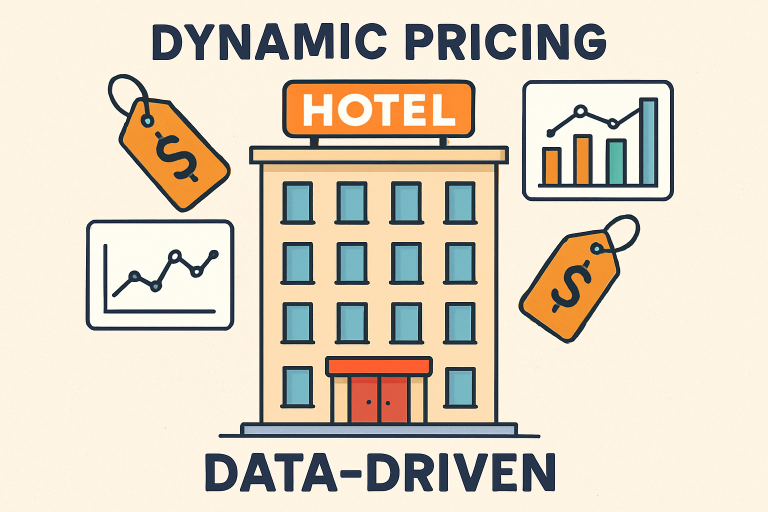As competition in the hospitality industry intensifies, hotels are increasingly seeking new technologies to optimize revenue, streamline operations, and satisfy evolving guest expectations. One of the most significant developments is the use of smart pricing tools, which deliver powerful revenue management capabilities by harnessing real-time data from various sources. Intelligent automation and advanced analytics solutions, such as Revenue Analytics’ dynamic pricing software for hospitality industry, have taken center stage in innovative hotel strategies, ushering in a new era of dynamic room pricing and data-driven decision-making.
By continuously analyzing up-to-the-minute market signals, smart pricing systems empower hoteliers to make fast, precise adjustments to their rates—and ultimately outperform traditional pricing approaches. The result is increased profitability, reduced manual workloads, and improved guest satisfaction, as rate changes become more responsive to actual demand and market shifts. Dynamic pricing isn’t just for large global chains. Independent and boutique hotels are also turning to these solutions, recognizing the critical role of robust pricing strategies in sustaining business growth and weathering unpredictable demand cycles. The effective adoption of advanced pricing tools enables all hotels, regardless of size, to compete more effectively against larger brands.
Major industry voices have highlighted how artificial intelligence is becoming a decisive force within the sector, powering more agile and competitive pricing.
The Rise of Dynamic Pricing in Hospitality
Dynamic pricing—often referred to as surge or demand pricing—represents a fundamental shift from static rate cards to flexible pricing strategies that are influenced by real-time market conditions. Typically, these algorithms consider factors such as competitor rates, actual booking pace, mobile trends, special local events, and even seasonal or weather shifts. According to research from McKinsey, leveraging dynamic pricing can boost hotel revenues by up to 10%, while also optimizing occupancy over both peak and off-peak periods.
The popularity of dynamic pricing has grown as travel patterns have become less predictable and consumer expectations have increased. With smart pricing, hotels are better positioned to capture revenue uplifts during spikes in demand, as well as minimize the risk of vacant rooms when travel slows.
How Smart Pricing Tools Work
Smart pricing solutions process vast sets of data in real-time, parsing information from internal sources—such as historical booking trends and occupancy rates—alongside external signals, including competitor pricing, local attractions, and even airline booking trends. Some advanced systems also incorporate weather forecasts and social media sentiment to anticipate emerging changes in demand. AI-powered revenue management platforms, for instance, can identify impending demand spikes and adjust rates instantly, enabling hotels to optimize both occupancy and room revenue.
These tools are commonly integrated with property management systems (PMS), channel managers, and booking engines, ensuring a seamless flow of pricing updates across all distribution channels. They also eliminate manual guesswork, providing granular pricing recommendations for every room type and date, while learning and adapting over time.
Benefits of Implementing Smart Pricing Tools
Hotels that embrace intelligent pricing technologies consistently report significant competitive advantages, including:
- Increased Revenue: Optimal rate adjustments can drive revenue gains between 5% and 30%, far exceeding the results possible with static pricing structures.
- Higher Occupancy: By matching prices to fluctuating demand, smart pricing ensures that room occupancy remains strong—even during off-season or low-traffic periods.
- Operational Efficiency: With the time-consuming task of manual rate management automated, staff can focus on guest service, upselling, and other core business needs.
Real-World Applications
Major hotel brands are already seeing tangible results from smart pricing initiatives. For instance, Marriott International has implemented AI-driven pricing systems that analyze real-time booking patterns, competitor rates, and local traffic data, resulting in a 17% increase in Revenue per Available Room (RevPAR). Smaller independent hotels have also realized increased market share simply by acting quickly on market signals that previously went unnoticed or unaddressed.
Challenges and Considerations
Even with substantial upsides, implementing smart pricing presents some notable challenges:
- Data Accuracy: The performance of any pricing tool relies heavily on the accuracy and completeness of its data sources. Poor data can yield suboptimal price recommendations and missed opportunities.
- System Integration: Seamlessly pairing a hotel’s pricing engines with its PMS, CRS, and online distribution channels can be technically complex, requiring investment in both technology and training.
- Guest Perception: Transparency is key. Sudden or unexplained price shifts can frustrate guests, so clear communication through pricing policies and flexible booking terms is essential for maintaining trust.
Future Outlook
As technology continues to advance, the adoption of AI-powered pricing tools in hospitality is expected to accelerate. Machine learning models are anticipated to incorporate even more nuanced signals—such as macroeconomic indicators or real-time traveler sentiment—to refine pricing accuracy and effectiveness further. Hotels that prioritize the integration of these platforms will be best equipped to navigate rapidly evolving travel markets and anticipate shifting guest preferences.
Conclusion
The evolution of smart pricing in hospitality marks a paradigm shift in how hotels approach revenue management. By adopting sophisticated, data-driven solutions, hotels can unlock new revenue opportunities, maintain robust occupancy, and enhance operational efficiency. As guest expectations rise and market dynamics become more volatile, these tools are no longer a luxury—they are a strategic imperative for long-term success.
